Key Takeaways
- German flag colors (black, red, gold) emerged in the 19th century as symbols of unity and freedom and continue to represent national identity today (Flag of Germany).
- Bavarian blue and white derive from the Wittelsbach heraldry and evoke Alpine tradition; they’re celebrated in Oktoberfest décor and regional folk art (Bavarian flag).
- Black signifies strength, elegance, and formality in German culture, from medieval eagles to modern interiors.
- Red brings vibrancy and life—seen in folk costumes like the Bollenhut and in Hanseatic city heraldry.
- Gold (yellow) adds warmth, prestige, and festivity—gilded Baroque palaces, Christmas lights, and postal service vans all showcase it.
- Practical design tips cover interior palettes, fashion pairings, exterior schemes, and graphic branding, illustrating how to weave these hues into cohesive, culturally rich spaces.
Introduction
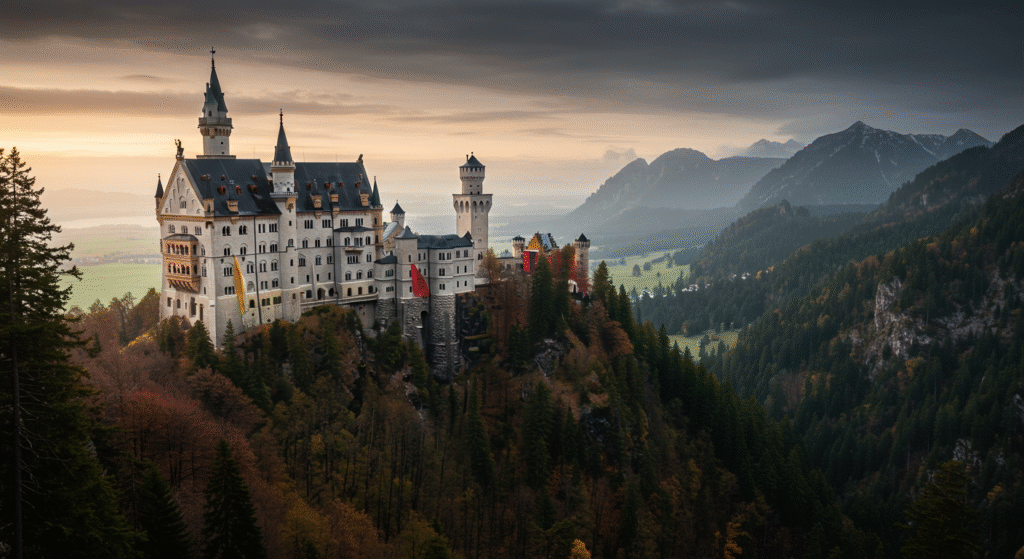
Germany’s palette is as diverse as its landscapes—black forests, red brick cities, golden palaces, and Bavarian blue skies. These colors tell stories of medieval empires, revolutionary fervor, rural traditions, and cutting‑edge design schools. This guide explores how black, red, gold, and Bavarian blues have shaped German identity and how you can bring their depth and character into decor, fashion, and branding.
Rather than abstract theory, you’ll find concrete tips, vivid examples, and balanced palettes you can adapt—whether you’re redecorating a room, planning a seasonal celebration, or crafting a brand identity. Let’s journey through Germany’s color spectrum and discover practical, expressive ways to use it in modern design.
1. German Flag Colors in History and Symbolism
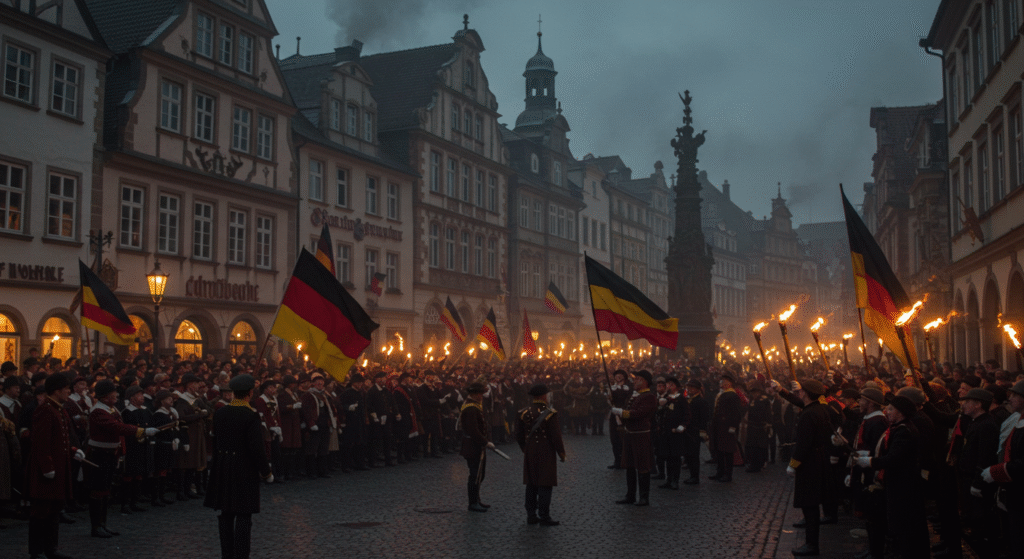
1.1 Origins of Black‑Red‑Gold
The tricolor of black, red, and gold first appeared in the uniforms of the Lützow Free Corps in 1813, volunteers fighting Napoleon’s forces. Their black coats bore red facings and brass (gold‑colored) buttons. Students in nationalist fraternities adopted these colors, and at the 1832 Hambach Festival, crowds waved black‑red‑gold flags as a call for German unity and liberty. Scholarly sources trace the usage to the 1848 Revolutions, when the Frankfurt Parliament proposed these hues for a united German nation. The choice was partly inspired by the Holy Roman Empire’s black eagle on a golden field, with red claws—a subtle nod to imperial legacy without invoking monarchical rule.
1.2 Symbolism of the Tricolor
Over decades, Germans infused the tricolor with layered meanings. Black came to represent overcoming oppression, red symbolized the courage and blood of patriots, and gold signified hope and enlightenment. Although not officially codified, these associations echo popular interpretations. The colors traveled through exile circles during the Bismarck era and reemerged in 1919 as the Weimar Republic’s flag. After World War II, both East and West Germany adopted variants of black‑red‑gold, cementing its status as the democratic emblem. Today, it adorns government buildings and sports arenas alike, uniting citizens across political divides.
1.3 Modern National Significance
On German Unity Day (October 3) and during FIFA World Cups, black, red, and gold flood stadiums, streets, and social media. The Bundesadler (federal eagle) set against a golden shield highlights official use, while casual fans sport scarves and face paint. Commercial logos—like DHL (red text on yellow vans)—echo the palette, integrating national symbolism into everyday life. Designers lean on the tricolor to convey reliability and pride, often by suggesting the colors more than depicting them literally. This subtlety ensures the palette feels fresh, not kitschy.
2. Bavarian Blue and White: Regional Colors of Bavaria
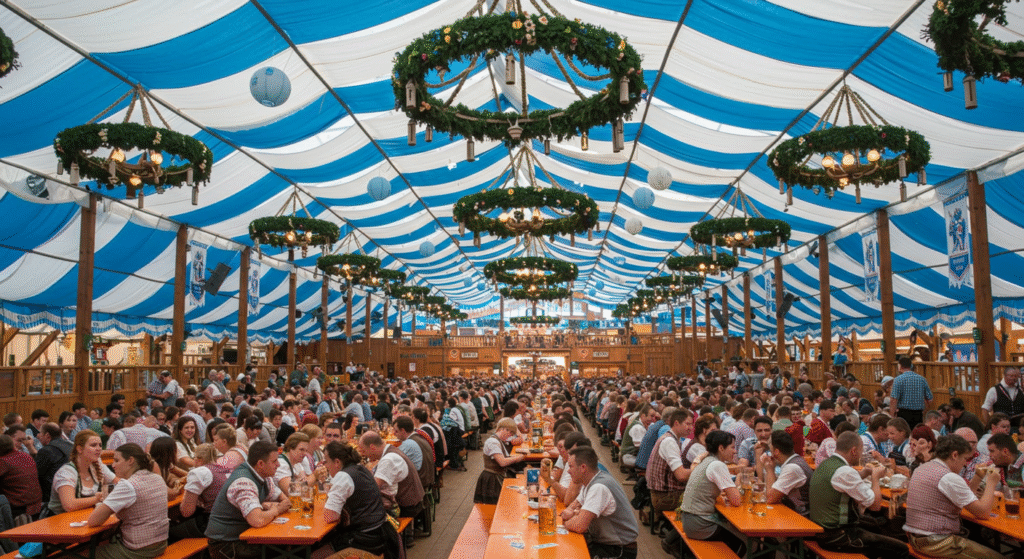
2.1 Heraldic Roots of White and Blue
Bavaria’s lozenge pattern of white and sky blue comes from the coat of arms of the Wittelsbach dynasty in 1242. When the Wittelsbachs inherited the counties of Bogen, they adopted the white‑blue diamonds. Bavaria’s constitution later codified white‑blue as state colors, and locals insist on saying “white and blue”—not the other way around. The hues evoke the Alpine sky and snow, lending them an almost natural legitimacy beyond mere heraldry.
2.2 Festival Flair: Oktoberfest and Beyond
Few events capture Bavarian colors so vividly as Oktoberfest in Munich. Massive beer tents are swathed in blue‑white stripes, tablecloths ripple with checks, and staff don Tracht featuring these hues. Outside, Maypoles (Maibaum) spiral blue and white ribbons, village banners fly the lozenge flag, and local breweries brand everything from steins to signage in the regional palette. This festive association makes blue and white shorthand for Bavarian hospitality worldwide.
2.3 Contemporary Uses in Design
Beyond periodic fairs, Bavarian blue lends a refreshing accent in kitchens, patios, and children’s rooms. Gingham textiles, patterned tiles, and ceramic dishware introduce the motif without overwhelming. In modern homes, a single sky‑blue accent wall or blue‑trimmed cabinetry can evoke Alpine calm. Designers often pair the palette with light wood floors, white walls, and greenery—recreating an Alpine inn’s airy feel in urban apartments.
3. Black: A German Color of Strength and Elegance
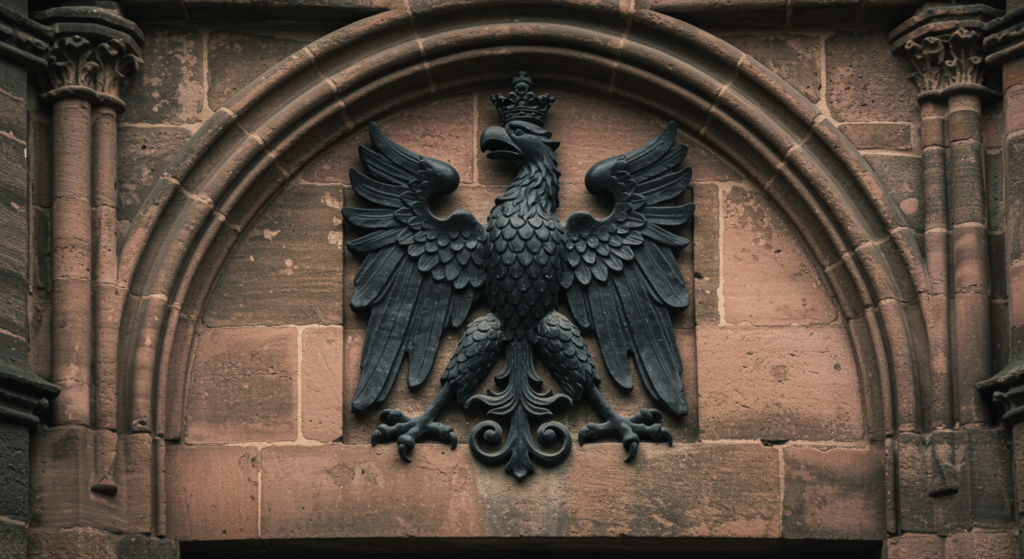
3.1 Medieval and Imperial Associations
Black has long signified power in German lands. The Teutonic Knights bore a black cross; the Holy Roman Empire’s banner featured a formidable black eagle on gold. Prussia embraced black uniforms and banners, elements later woven into the German Empire’s flag (black‑white‑red). Black thus connotes authority, tradition, and solemnity.
3.2 Fashion’s Dependable Neutral
In traditional Tracht, black appears in felt hats, leather boots, and bodice embroidery—often offset by bright trims. Modern German wardrobes likewise lean on black for its slimming, versatile qualities. Whether it’s Berlin streetwear or formal attire, black communicates sophistication. Pairing it with a single vivid accent (a red scarf or gold brooch) nods to national hues without costume-level commitment.
3.3 Architectural Accents
Half-timbered houses (Fachwerkhäuser) typically display dark beams against white plaster, a hallmark of medieval and renaissance architecture. Cast‑iron railings, lamp fixtures, and hardware in black provide contrast on facades and interiors. In contemporary builds, black window frames and matte cabinetry inject drama into minimalist spaces, echoing the crisp outlines of historical structures.
4. Red: Vibrant Accents from Tradition to Modernity
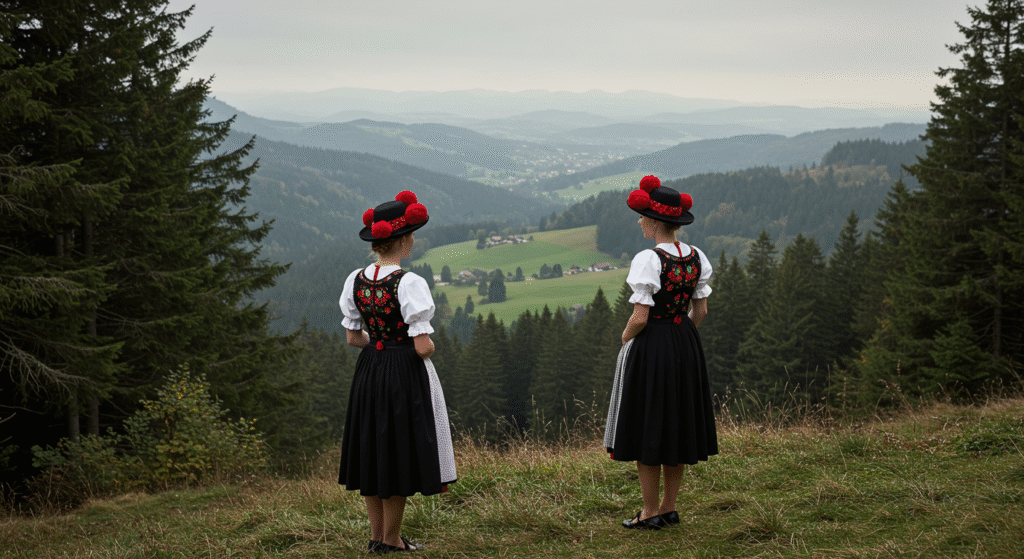
4.1 Heraldry and Hanseatic Roots
Cities like Hamburg and Bremen flew red-and-white banners in the Hanseatic League—trade hubs of medieval northern Germany. The Brandenburg eagle displayed red claws, while state flags incorporated vivid red stripes. Such usage cemented red as a symbol of commerce, valor, and civic pride.
4.2 Folk Costume Highlights
Red is a star in regional costumes: the Black Forest’s Bollenhut features red pompoms for unmarried women; Bavarian dirndls often sport red bodices or skirts, pairing joyfully with white blouses. At Easter and Christmas, local dress and market stalls burst with red ribbons, garlands, and gingerbread hearts.
4.3 Design Applications
In interiors, red shines as a focal accent—think red throw pillows on a neutral sofa, a single scarlet armchair, or a vibrant rug anchoring a living room. In rustic settings, red-and-white checks on curtains or table linens evoke cozy kitchen memories. For modern flair, red artwork or cabinetry can boldly punctuate a minimalist white space.
5. Gold (Yellow): Gilded Hues in German Art and Heritage
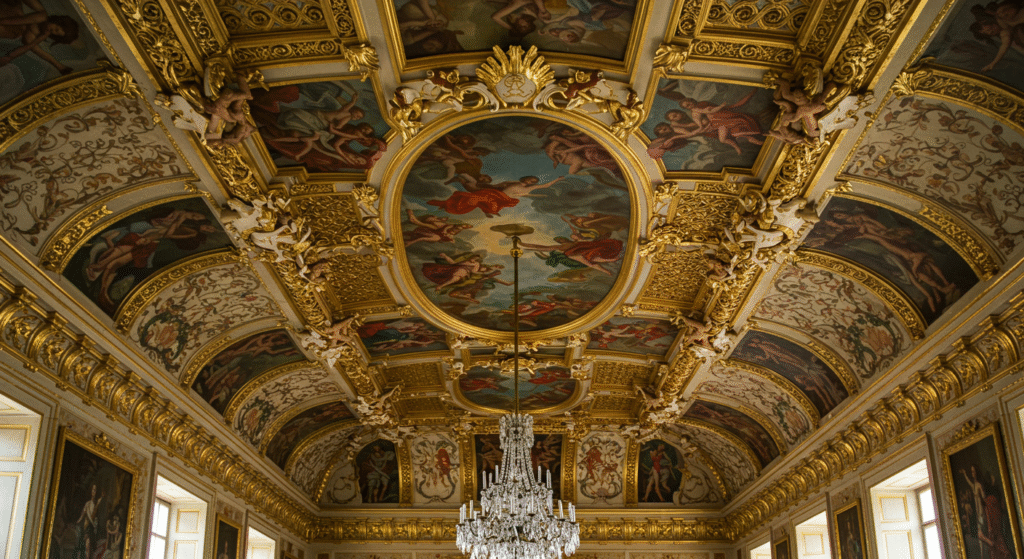
5.1 Imperial Splendor
Gold adorned crowns, palace interiors, and the Holy Roman eagle’s backdrop, symbolizing divine right and grandeur. Baroque churches and royal residences continue to showcase gilded stucco, mirrors, and frames, reflecting light and evoking opulence.
5.2 Warm Accents in Decor
Brass and gold‑tone fixtures—lamps, hardware, mirror frames—lend a refined glow to modern interiors. Golden-yellow textiles, from velvet cushions to drapes, foster a sense of comfort. Historically, painted inscriptions on timber beams used gold paint to highlight construction dates or religious verses.
5.3 Festive Cheer
At Christmas, Germans dress trees in gold tinsel, stars, and lights, creating an amber glow that warms the darkest winter nights. Spring festivals feature golden wheat sheaves and forsythia branches. This seasonality shows gold’s role in marking time and celebration.
6. Traditional German Fashion: Dirndls, Lederhosen, and Colors
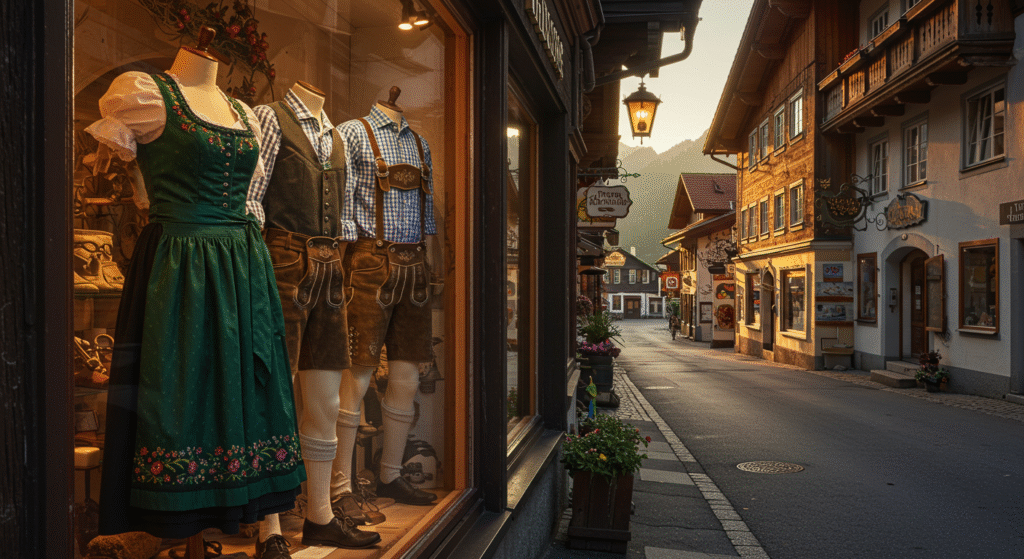
6.1 Dirndl Color Stories
A dirndl combines bodice, blouse, skirt, and apron—each chosen for color harmony. Classic palettes include navy-and-white, wine-red-and-cream, or emerald-green-and-black, often embellished with floral embroidery. Patterned aprons or bodices echo folk motifs, while black bodices offer dramatic contrast.
6.2 Lederhosen and Color Checks
Men’s Lederhosen outfits pair natural leather breeches with checkered shirts—red, blue, or green checks are common. Wool vests in hunter green, burgundy, or black add warmth, often trimmed with gold or silver embroidery. Socks, hats, and accessories (like the Gamsbart tuft) introduce subtle color notes.
6.3 Regional Variations
Costumes vary: Franconian dresses may favor pastels; northern folk wear highlight red or purple shawls; Sorbian brides once donned multicolor floral ensembles. Each region’s palette reflects local landscape and heritage. Translating this to decor suggests pairing core neutrals with one regional accent, such as red in Black Forest style or blue in Alpine themes.
7. German Interior Design: From Rustic to Modern
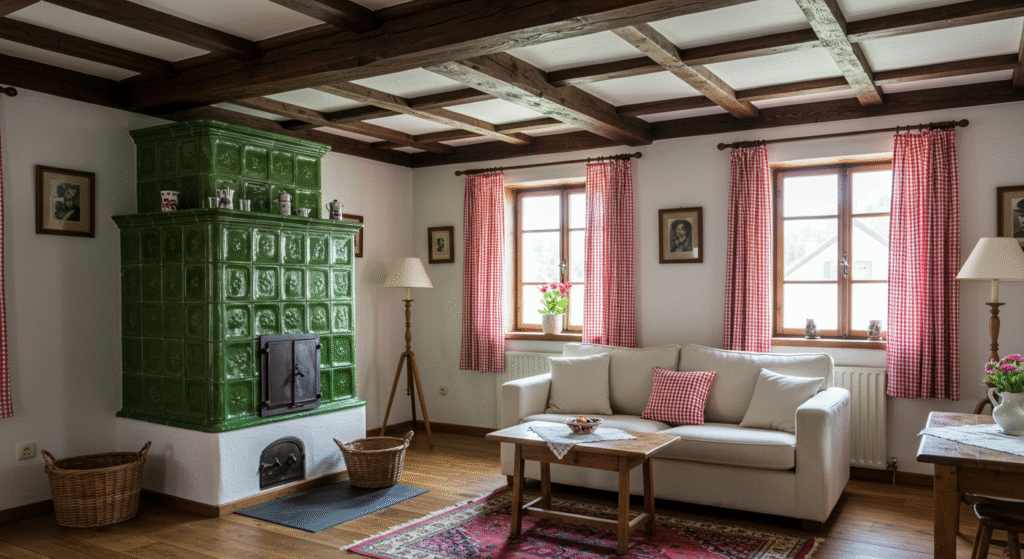
7.1 Bavarian Rustic Charm
A traditional Bauernstube features wood beams, white walls, and red-and-white homey textiles—gingham curtains or embroidered cushions. Green ceramics (kachelöfen) and floral folk art add layers. Natural materials dominate, with color appearing in functional accents.
7.2 Modern Minimalism
Influenced by the Bauhaus movement, contemporary German interiors favor neutral palettes—white, gray, black, and light wood—with singular bold accents. A red chair or yellow vase in a monochrome room creates impact. Quality lighting and uncluttered layouts keep spaces calm and functional.
7.3 Blending Eras
Mixing antique furniture (an ebonized Biedermeier cabinet) with modern art (abstract red-and-black painting) yields dynamic cohesion. Retain architectural heritage—exposed beams or tile stoves—while inserting streamlined pieces in complementary colors. The result is a layered, personal environment.
8. Exterior Color Schemes in German Architecture
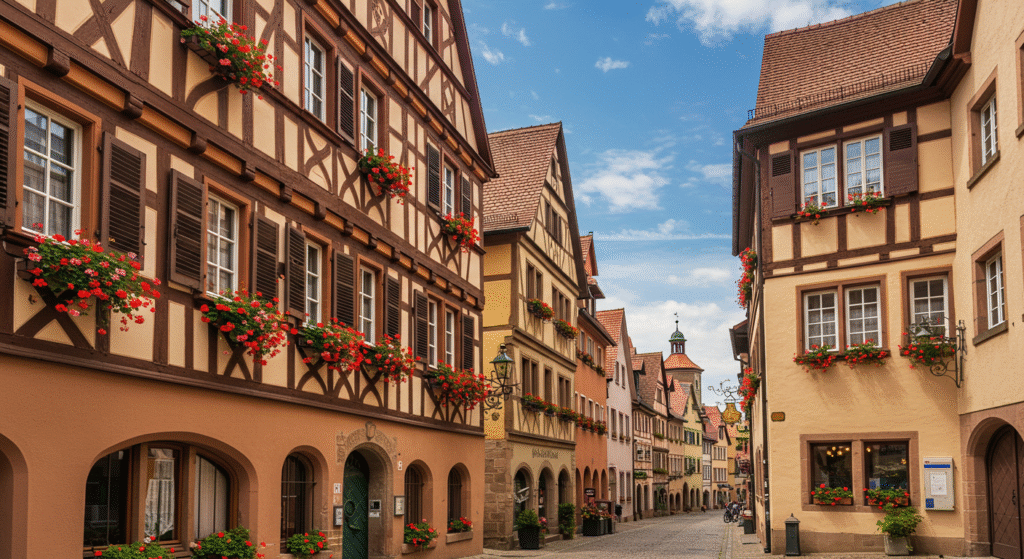
8.1 Half‑Timbered Geometry
Fachwerkhäuser display dark beams against white or pastel infill, forming striking patterns. Some regions feature colored beams (red or green) and painted carvings in gold or other hues. Homeowners can mimic this by contrasting trim colors or accent walls on modern exteriors.
8.2 Painted Facades
Towns like Dinkelsbühl showcase pastel stucco houses in yellows, pinks, and blues, often with white trim. Coastal Hanseatic cities of brick and white create a distinct red‑and‑white aesthetic. Freshly painted front doors in bold primary colors add curb appeal even in neutral streetscapes.
8.3 Contemporary Expressions
Modern buildings often use neutral materials but accent key elements—window frames, entrance panels—with vivid colors. Urban murals and colored lighting on iconic structures (e.g., the Allianz Arena’s nightly illuminations) demonstrate how selective color can transform bland surfaces into landmarks.
9. German Graphic Design and Branding Colors

9.1 Bauhaus and Primaries
The Bauhaus school championed simple shapes and primary colors: red, blue, yellow, black, and white. This ethos persists in modern German graphic design—flat layouts, bold typography, and restrained palettes create clarity and impact.
9.2 Heraldic Hues in Logos
Brands subtly reference national or regional colors: BMW uses blue‑white quadrants, honoring Bavaria; Porsche features the black‑red‑gold of Württemberg’s coat of arms; Deutsche Post sports black icons on a golden yellow background, echoing the postal horn on a shield.
9.3 Contemporary Brand Palettes
Tech companies (Siemens, SAP) prefer cool blues and neutrals; retail chains (Aldi, Lidl) employ bright blue, yellow, and red for visibility. The trend is minimal base tones with one or two vibrant accents, continuing Germany’s legacy of purposeful color use.
10. Festivals and Seasonal Decor in German Culture
10.1 Oktoberfest: Blue‑White Revelry
Oktoberfest tents drape blue‑white stripes; tablecloths and Bavarian flags abound. Beers flow gold, paired with green garlands and red pretzels. Recreate the ambiance with checkered linens, beer stein displays, and wooden signage.
10.2 Christmas: Red and Gold Splendor
At Christkindlesmarkt, red booths glow with golden lights. Nutcrackers wear red coats with gold trim; evergreen wreaths sport red ribbons; Advent candles burn crimson. Infuse your holidays with red-and-gold table runners, candle arrangements, and festive ornaments.
10.3 Other Celebrations
Karneval invites rainbow hues; May Day uses green birch branches and multicolored ribbons; Ostern shows pastel eggs on bare branches. Seasonal decor can rotate—Easter egg trees, Maypole centerpieces, autumnal harvest displays—if you wish to echo German traditions year‑round.
11. Applying Black, Red, and Gold in Home Decor
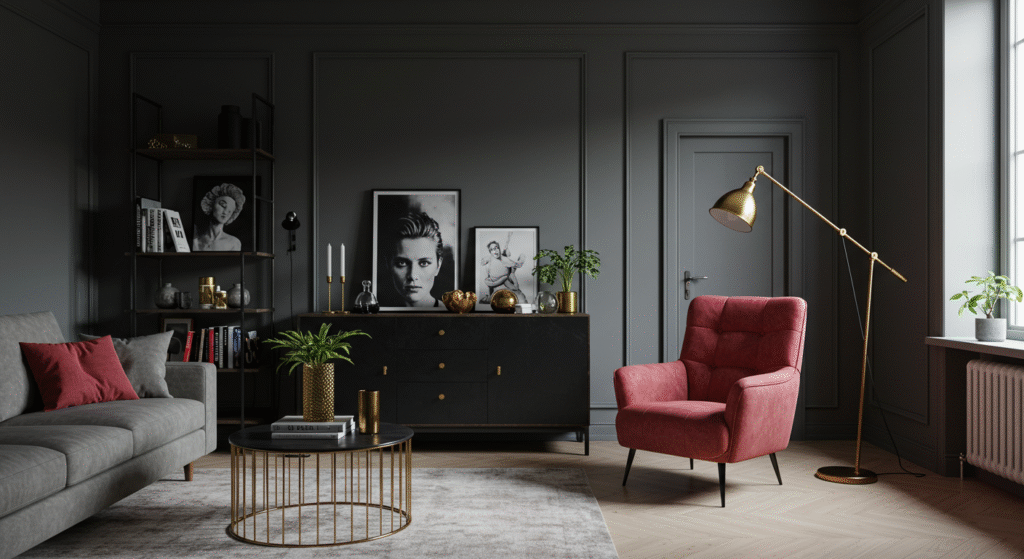
11.1 Balancing Black and Red
Use black furniture (a sofa, bookshelf) as a neutral anchor. Introduce red accents—pillows, rugs, art—at roughly a 10–20% ratio to prevent overwhelm. Muted variants (charcoal, burgundy) soften high contrast, maintaining character without harshness.
11.2 Warming with Gold
Incorporate gold‑tone metals (brass lamps, mirror frames) and yellow textiles (velvet throws, silk pillows). Natural wood furniture also reads as golden; combined with warm lighting, it ensures black‑red combos never feel chilly.
11.3 Cohesive Tricolor Schemes
Adopt the 60‑30‑10 rule: perhaps 60% neutrals/wood (gold base), 30% black, 10% red. Use patterned rugs or throws blending all three hues. Mind undertones—choose reds and golds with similar warmth—to create unity. Small spaces benefit from sparing use: a black console table, a gold mirror, and a red vase in an entryway, for example.
12. Designing with Bavarian Blue: Tips and Pairings
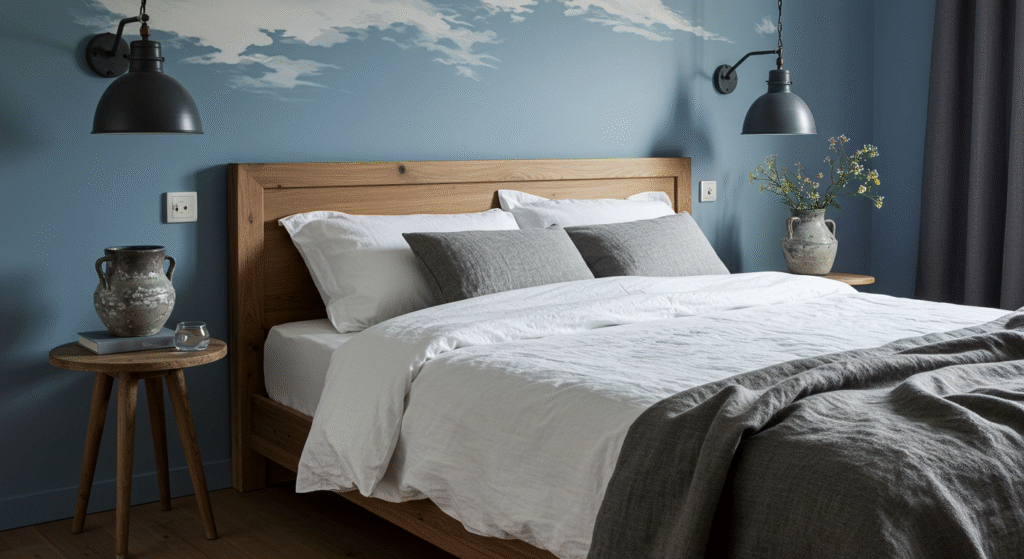
12.1 Patterned Textiles
Blue‑white gingham, harlequin lozenges, and ceramic tile motifs anchor a Bavarian theme. Accent a modern white kitchen with a blue check tablecloth or add blue-and-white throw pillows to a neutral sofa.
12.2 Neutral Complements
Pair sky blue with white, light gray, or warm wood to mimic Alpine chalet warmth. A blue sofa on a wood floor, white walls, and a gray rug evoke mountain lodges without kitsch. Green plants add natural freshness.
12.3 Modern Interpretations
Scale up patterns (oversized checks), mix blue shades (navy with sky blue), or use solid color blocks (a single blue accent wall). Integrate felt in blue or Loden wool to hint at traditional materials in sleek forms.
13. Color Palettes and Combinations Inspired by Germany
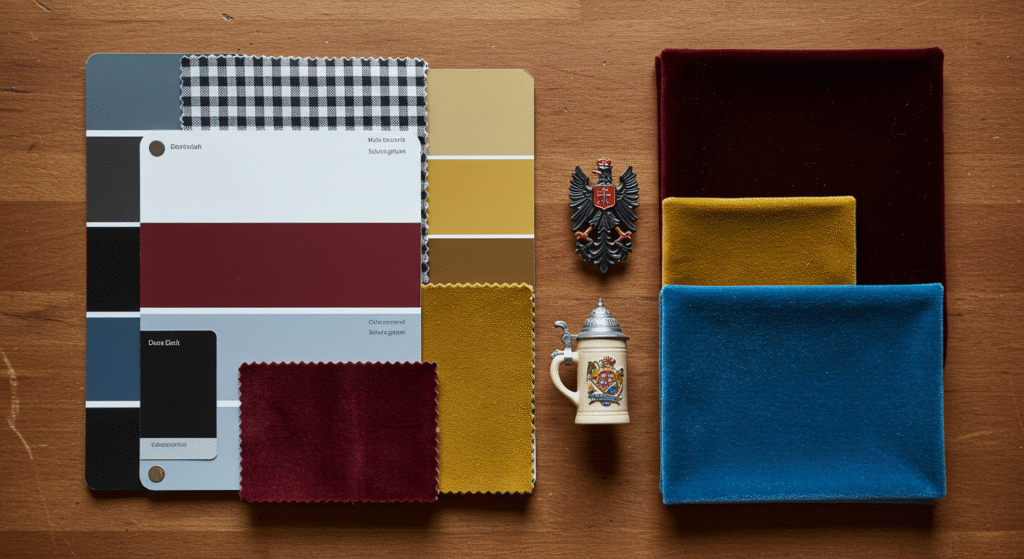
13.1 Black and Gold Elegance
- Palette: Black, Gold, Cream
- Inspiration: Prussian uniforms, Art Deco
- Use: Formal living rooms, home libraries; black furniture, gold fixtures, cream walls
13.2 Rustic Red and White Charm
- Palette: Red, White, Wood Brown, Grass Green
- Inspiration: Bavarian farmhouses, Black Forest folk art
- Use: Kitchens/dining areas; gingham linens, wooden tables, green accents through plants
13.3 Bavarian Blue with Natural Hues
- Palette: Sky Blue, White, Warm Wood, Edelweiss Gray
- Inspiration: Alpine skies, wooden chalets
- Use: Bedrooms/bathrooms; blue walls or textiles, white accents, wood furniture, gray decorative pieces
14. Summary Table of German Colors in Design
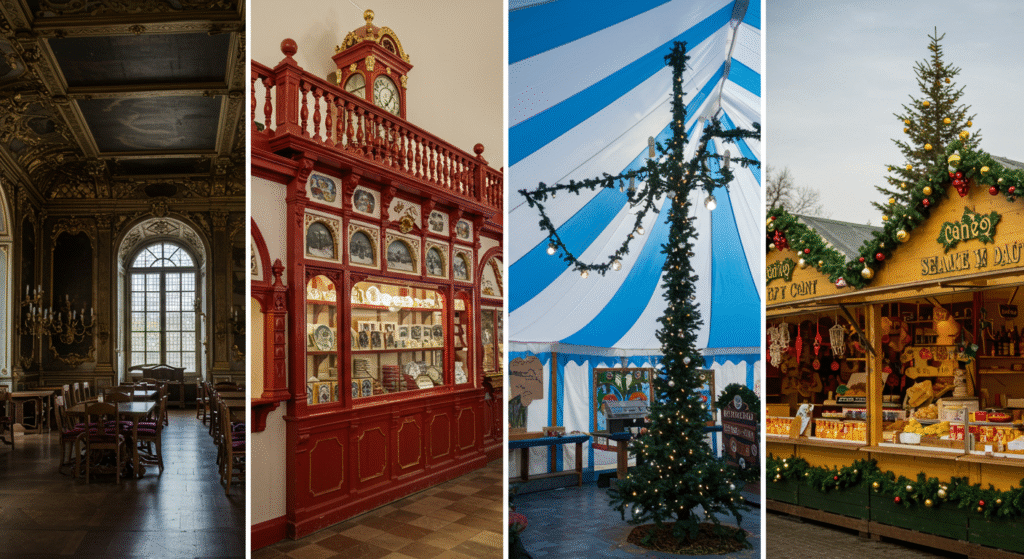
| Color Group | Historical Roots & Symbolism | Design Applications |
|---|---|---|
| Black, Red, Gold | 19th‑C flag of unity, Holy Roman Empire eagle, Prussian heritage | Balanced tricolor interiors, formal accents, patriotic nods |
| Bavarian Blue & White | Wittelsbach heraldry, Alpine associations, Oktoberfest motifs | Gingham textiles, blue accent walls, chalet‑style decor |
| Black & Gold Elegance | Imperial regalia, Baroque architecture | Luxurious living rooms, metallic accents, Art Deco styles |
| Rustic Red & White | Folk costumes (Bollenhut, dirndl), Hanseatic trade banners | Country kitchens, festive decor, gingham patterns |
| Blue & Wood Neutrals | Alpine landscapes, chalet interiors, modern minimalism | Fresh bedrooms, bathrooms, Scandi‑Bavarian hybrids |
Conclusion
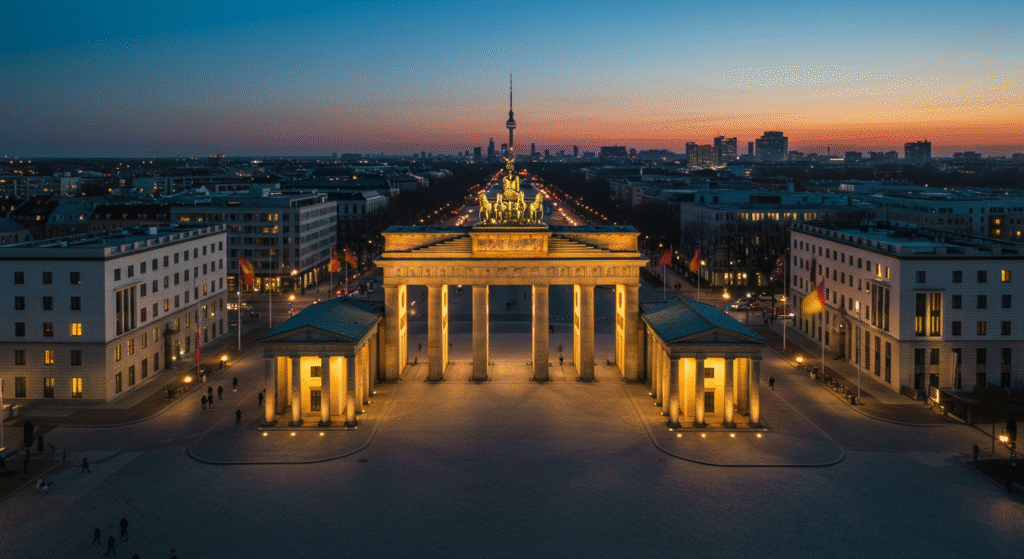
Germany’s palette of black, red, gold, and Bavarian blues weaves history, culture, and design innovation into a vibrant tapestry. From medieval heraldry to Bauhaus minimalism, from Oktoberfest revelry to Black Forest charm, these hues carry meaning and mood.
By understanding their origins and contexts, you can harness their power—whether in dramatic black‑and‑gold living rooms, cozy red‑and‑white kitchens, luminous gold‑accented spaces, or serene blue‑white retreats.
Thoughtful balance, selective accents, and a nod to tradition ensure your designs resonate with authenticity and style. Embrace Germany’s spectrum, let these colors tell your story, and enjoy the warmth, energy, and elegance they bring.
FAQ

Q: How can I avoid a literal “flag look” when using black, red, and gold?
A: Use one color as a dominant background (e.g., warm neutrals or wood), another as a structural anchor (black furniture or trim), and the third sparingly as accent (small red décor). Patterns that blend the three in moderation—like a rug or throw—also unify the palette subtly.
Q: What’s the easiest way to add Bavarian flair to a modern space?
A: Start with a small patterned textile—a blue-and-white gingham pillow or a single piece of tile backsplash. Pair with neutral walls and wood tones. This hint of Bavarian blue-and-white invokes Alpine charm without overcommitting to rustic décor.
Q: Can I mix black‑red‑gold and Bavarian blue‑white palettes?
A: Yes—consider zoning: use black-red-gold in one area (e.g., living room) and blue-white in another (e.g., kitchen) to celebrate both national and regional identities. Or combine gold and wood neutrals with touches of both blue and red in shared spaces, balancing the warmth and coolness.
Q: Which neutrals best complement these German palettes?
A: White, cream, and light gray are versatile, brightening the bold hues. Warm wood tones read as gold and tie to rustic traditions. Charcoal or taupe can ground blue-and-white schemes for a more contemporary feel.
Q: Are there easy seasonal swaps for German-themed decor?
A: Absolutely. For Christmas, layer in red-and-gold ornaments and greenery. At Oktoberfest, swap table linens to blue-white stripes and display beer steins. In spring, hang painted eggs on branches for an Easter tree. Seasonal transitions keep your decor dynamic and culturally resonant.
Q: Where can I find authentic German textiles and accents?
A: Check specialty shops for Bavarian textiles, folk art stores for hand‑painted pottery, and online retailers offering Fachwerk‑style décor. Many heritage brands export gingham linens, Loden wool blankets, and metal beer steins worldwide—bringing authentic German craftsmanship to your home.

Anna West, the visionary behind Clothes Color Guide, is our go-to for all things fashion. Merging the finest of runway trends with everyday style, she demystifies the world of color and pattern. While clothing is her mainstay, Anna also shares insights on interior design, pet care, and relationship advice. Dive into her articles and emerge with a vibrant perspective on style and life.
Reviewed By: Joanna Perez and Marcella Raskin
Edited By: Lenny Terra
Fact Checked By: Sam Goldman
Photos Taken or Curated By: Matthew Mansour
